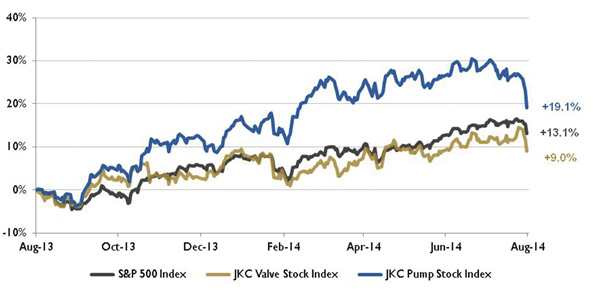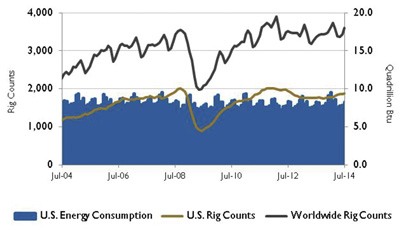The Jordan, Knauff & Company (JKC) Valve Stock Index was up 9 percent during the last 12 months, staying under the broader S&P 500 Index, which was up 13.1 percent. The JKC Pump Stock Index was up 19.1 percent for the same time period.1 The Institute for Supply Management’s Purchasing Managers’ Index (PMI) increased 1.8 percent in July to a reading of 57.1 percent, its highest level since April 2011. The PMI has gradually increased each month since declining sharply in January 2014. The Production Index increased from 60 percent to 61.2 percent. The index for raw material costs moved higher to 59.5 percent from 58 percent and averaged 59.1 percent through the first seven months of 2014. This is a meaningful increase over last year’s average of 53.8 percent. The U.S. Commerce Department reported that gross domestic product (GDP) rebounded in the second quarter of the year, growing at a 4 percent annual pace. Consumer spending on autos, appliances and furniture and business investment in technology and industrial equipment helped the economy grow. Historical numbers were also revised because the decline in the first quarter moved from 2.9 percent to 2.1 percent. The report also included revisions for the previous three years and showed that the underlying trend of economic growth was stronger than had been initially reported.
 Figure 1. Stock indices from August 1, 2013, to July 31, 2014. Source: Capital IQ and JKC research. Local currency converted to USD using historical spot rates. The JKC Pump and Valve Stock Indices include a select list of publicly-traded companies involved in the pump and valve industries weighted by market capitalization.
Figure 1. Stock indices from August 1, 2013, to July 31, 2014. Source: Capital IQ and JKC research. Local currency converted to USD using historical spot rates. The JKC Pump and Valve Stock Indices include a select list of publicly-traded companies involved in the pump and valve industries weighted by market capitalization. Figure 2. U.S. energy consumption and rig counts. Source: U.S. Energy Information Administration and Baker Hughes Inc.
Figure 2. U.S. energy consumption and rig counts. Source: U.S. Energy Information Administration and Baker Hughes Inc. Figure 3. U.S. PMI and manufacturing shipments. Source: Institute for Supply Management Manufacturing Report on Business and U.S. Census Bureau
Figure 3. U.S. PMI and manufacturing shipments. Source: Institute for Supply Management Manufacturing Report on Business and U.S. Census Bureau
